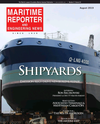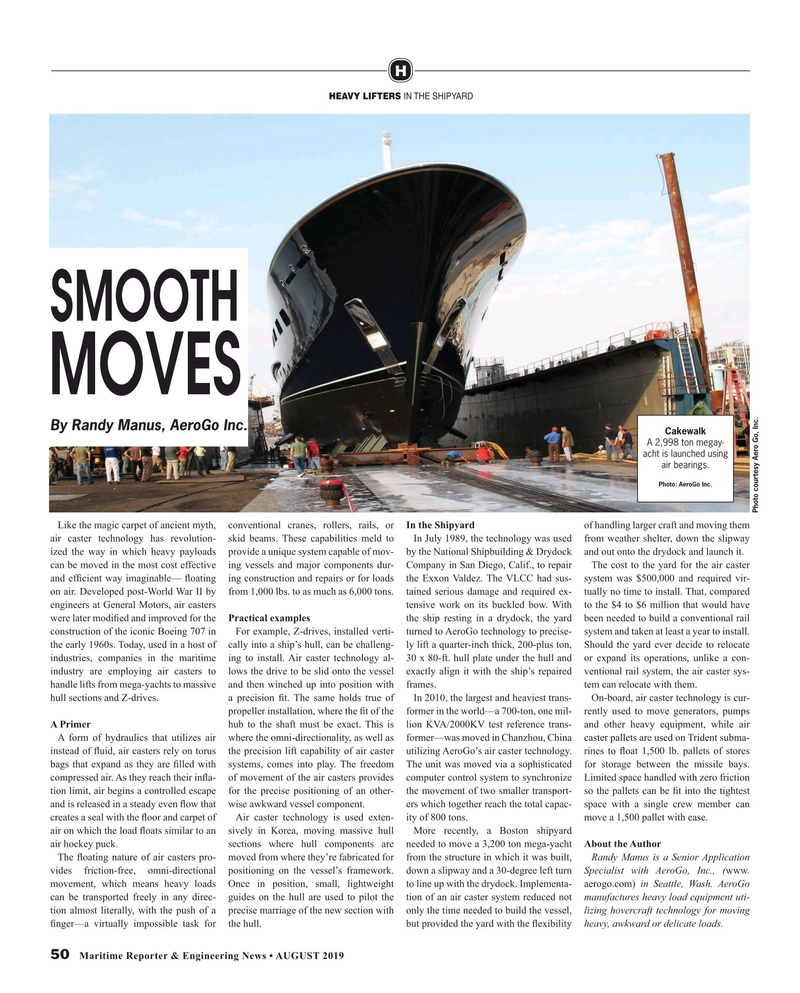
Page 50: of Maritime Reporter Magazine (August 2019)
The Shipyard Edition
Read this page in Pdf, Flash or Html5 edition of August 2019 Maritime Reporter Magazine
H
HEAVY LIFTERS IN THE SHIPYARD
SMOOTH
MOVES
By Randy Manus, AeroGo Inc.
Cakewalk
A 2,998 ton megay- acht is launched using air bearings.
Photo: AeroGo Inc.
Photo courtesy Aero Go, Inc.
Like the magic carpet of ancient myth, conventional cranes, rollers, rails, or In the Shipyard of handling larger craft and moving them air caster technology has revolution- skid beams. These capabilities meld to In July 1989, the technology was used from weather shelter, down the slipway ized the way in which heavy payloads provide a unique system capable of mov- by the National Shipbuilding & Drydock and out onto the drydock and launch it.
can be moved in the most cost effective ing vessels and major components dur- Company in San Diego, Calif., to repair The cost to the yard for the air caster and ef? cient way imaginable— ? oating ing construction and repairs or for loads the Exxon Valdez. The VLCC had sus- system was $500,000 and required vir- on air. Developed post-World War II by from 1,000 lbs. to as much as 6,000 tons. tained serious damage and required ex- tually no time to install. That, compared engineers at General Motors, air casters tensive work on its buckled bow. With to the $4 to $6 million that would have were later modi? ed and improved for the Practical examples the ship resting in a drydock, the yard been needed to build a conventional rail construction of the iconic Boeing 707 in For example, Z-drives, installed verti- turned to AeroGo technology to precise- system and taken at least a year to install. the early 1960s. Today, used in a host of cally into a ship’s hull, can be challeng- ly lift a quarter-inch thick, 200-plus ton, Should the yard ever decide to relocate industries, companies in the maritime ing to install. Air caster technology al- 30 x 80-ft. hull plate under the hull and or expand its operations, unlike a con- industry are employing air casters to lows the drive to be slid onto the vessel exactly align it with the ship’s repaired ventional rail system, the air caster sys- handle lifts from mega-yachts to massive and then winched up into position with frames. tem can relocate with them. hull sections and Z-drives. a precision ? t. The same holds true of In 2010, the largest and heaviest trans- On-board, air caster technology is cur- propeller installation, where the ? t of the former in the world—a 700-ton, one mil- rently used to move generators, pumps
A Primer hub to the shaft must be exact. This is lion KVA/2000KV test reference trans- and other heavy equipment, while air
A form of hydraulics that utilizes air where the omni-directionality, as well as former—was moved in Chanzhou, China caster pallets are used on Trident subma- instead of ? uid, air casters rely on torus the precision lift capability of air caster utilizing AeroGo’s air caster technology. rines to ? oat 1,500 lb. pallets of stores bags that expand as they are ? lled with systems, comes into play. The freedom The unit was moved via a sophisticated for storage between the missile bays. compressed air. As they reach their in? a- of movement of the air casters provides computer control system to synchronize Limited space handled with zero friction tion limit, air begins a controlled escape for the precise positioning of an other- the movement of two smaller transport- so the pallets can be ? t into the tightest and is released in a steady even ? ow that wise awkward vessel component. ers which together reach the total capac- space with a single crew member can creates a seal with the ? oor and carpet of Air caster technology is used exten- ity of 800 tons. move a 1,500 pallet with ease. air on which the load ? oats similar to an sively in Korea, moving massive hull More recently, a Boston shipyard air hockey puck. sections where hull components are needed to move a 3,200 ton mega-yacht About the Author
The ? oating nature of air casters pro- moved from where they’re fabricated for from the structure in which it was built, Randy Manus is a Senior Application vides friction-free, omni-directional positioning on the vessel’s framework. down a slipway and a 30-degree left turn Specialist with AeroGo, Inc., (www.
movement, which means heavy loads Once in position, small, lightweight to line up with the drydock. Implementa- aerogo.com) in Seattle, Wash. AeroGo can be transported freely in any direc- guides on the hull are used to pilot the tion of an air caster system reduced not manufactures heavy load equipment uti- tion almost literally, with the push of a precise marriage of the new section with only the time needed to build the vessel, lizing hovercraft technology for moving ? nger—a virtually impossible task for the hull. but provided the yard with the ? exibility heavy, awkward or delicate loads. 50 Maritime Reporter & Engineering News • AUGUST 2019
MR #8 (50-57).indd 50 7/31/2019 1:38:18 PM

 49
49

 51
51
